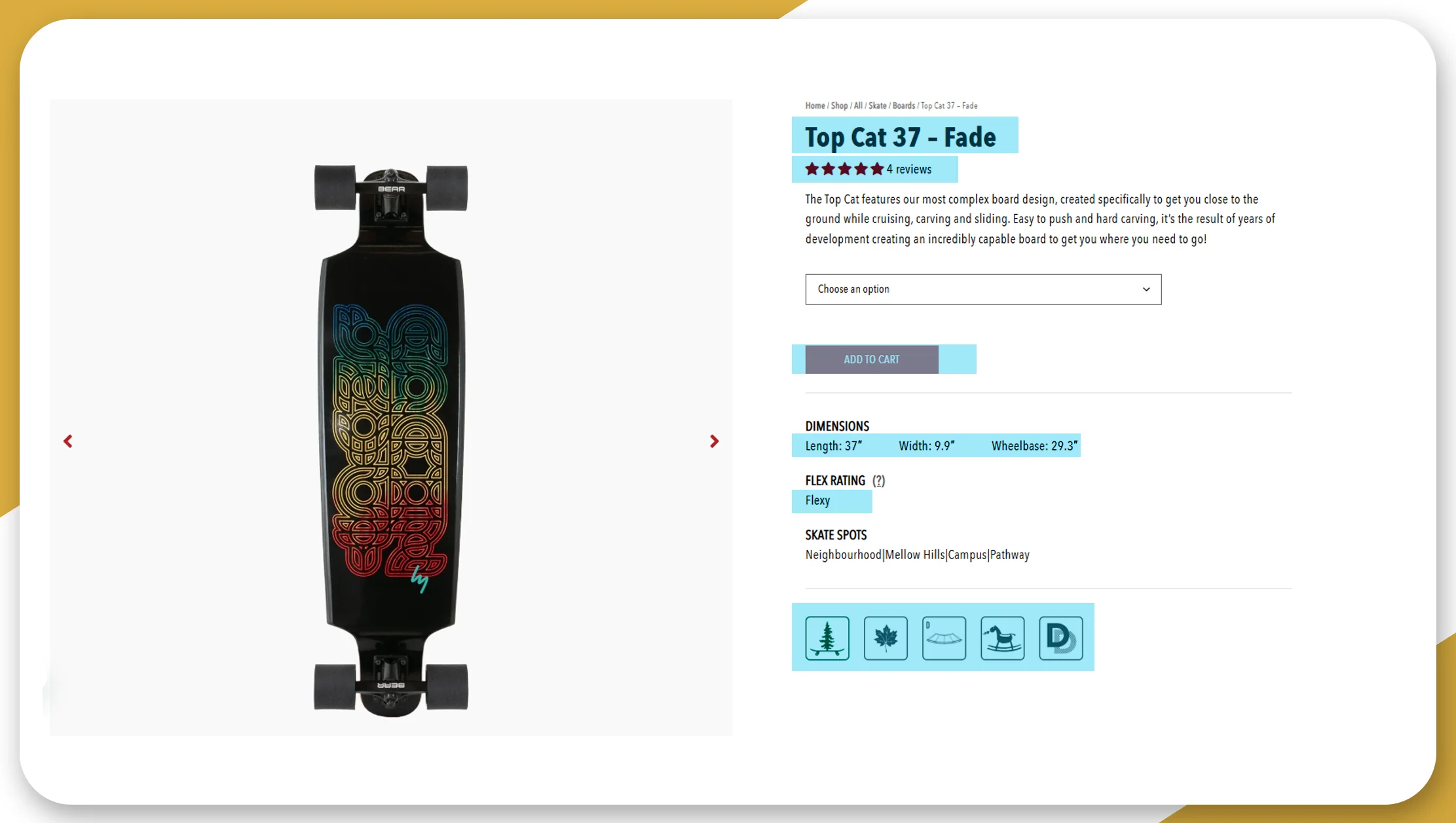.webp)

Introduction
Shopify has become one of the most popular e-commerce platforms, hosting millions of online stores worldwide. The wealth of data stored in Shopify stores can provide valuable insights for businesses, marketers, and researchers. Whether you’re looking to analyze product trends, monitor competitors, or gather pricing data, Scraping Shopify stores for data is a powerful strategy. This guide will walk you through everything you need to know to get started with Shopify data scraping in 2025.
What is Shopify Data Scraping?
Shopify data scraping refers to the process of extracting publicly available data from Shopify stores to gather valuable information for analysis and decision-making. This process enables businesses to collect data such as:
- Product details: Extract information about product names, prices, descriptions, images, and specifications.
- Inventory status and variations: Track availability, stock levels, and product variations like size, color, or style.
- Customer reviews and ratings: Gather feedback, star ratings, and comments to understand customer preferences and sentiments.
- Store categories and tags: Identify the organization of products into categories or tags, offering insights into trends and market positioning.
By using specialized tools or techniques, Shopify data scraping helps in compiling large datasets from online stores. This data can be analyzed to uncover actionable insights, such as identifying trending products, monitoring competitor pricing strategies, or evaluating customer sentiments. Businesses can use these insights to improve product offerings, optimize marketing strategies, and stay competitive.
It is important to note that Shopify data scraping should adhere to legal and ethical standards. Scraping publicly available data is generally permissible, but accessing private or restricted information without authorization violates terms of service and could result in legal consequences.
By leveraging the right tools and methodologies, Shopify data scraping transforms raw data into structured information, enabling businesses to make data-driven decisions effectively. Whether tracking e-commerce trends or gathering market intelligence, this process is a valuable asset for businesses looking to optimize their strategies in the competitive online marketplace.
Why Scrape Shopify Data?

Businesses and individuals leverage Shopify data scraping for numerous purposes, providing valuable insights to improve decision-making and strategy. Here are the key reasons for utilizing this technique:
1. Market Analysis
Scraping data from Shopify stores allows businesses to analyze market trends, consumer preferences, and purchasing behavior. By understanding what products are popular and how customers engage with them, businesses can better predict demand and tailor their offerings accordingly.
2. Competitor Monitoring
Shopify data scraping is a powerful tool for tracking competitor activities. It enables businesses to compare pricing strategies, product offerings, and ongoing promotions across similar stores. This information can help fine-tune your own strategies to maintain a competitive edge in the e-commerce landscape.
3. E-Commerce Optimization
By extracting data from successful Shopify stores, businesses can identify best practices and implement proven strategies to enhance their own online store’s performance. Insights into product descriptions, category organization, and customer engagement tactics can be instrumental in boosting sales and improving user experience.
4. Lead Generation
For individuals or businesses involved in marketing or outreach, Shopify data scraping can help build a comprehensive list of Shopify stores. This list can be used to target potential clients or partners for various campaigns, ensuring efficient and focused lead generation efforts.
When used ethically and within legal boundaries, Shopify data scraping becomes a valuable asset for gathering actionable insights. Whether it’s for understanding market dynamics, keeping an eye on competitors, optimizing e-commerce performance, or generating leads, this process empowers businesses to stay competitive and achieve growth in the fast-paced digital marketplace.
Legal Considerations

When engaging in Shopify data scraping, it is crucial to understand and adhere to the legal and ethical boundaries of this practice. Data scraping can provide valuable insights, but failing to comply with applicable laws and policies can lead to legal repercussions.
Firstly, always ensure compliance with Shopify’s terms of service. These terms often outline restrictions on automated data collection methods and specify the acceptable use of their platform. Violating these terms could result in penalties, account suspension, or legal action.
Focus exclusively on scraping publicly available data—information that is visible to any user visiting the store. Avoid attempting to access restricted or sensitive information, such as customer details or backend data, as this violates privacy regulations and terms of use.
Ethical practices are equally important. Ensure your scraping activities do not overload Shopify’s servers with excessive requests, as this could disrupt website performance. Implement rate-limiting and respect the platform's infrastructure to maintain ethical standards.
Additionally, familiarize yourself with regional data protection laws, such as the GDPR in Europe or the CCPA in California, to ensure compliance when handling scraped data.
By adhering to these legal considerations, businesses can responsibly leverage Shopify data scraping to gain valuable insights without breaching ethical or legal boundaries.
Step-by-Step Shopify Website Scraping Tutorial
Here’s a detailed Shopify website scraping tutorial to help you get started:
Step 1: Identify the Target Shopify Store

Begin by selecting the Shopify store or stores you want to scrape. Shopify stores typically have a uniform structure with URLs like https://storename.myshopify.com. This consistency makes it easier to locate and extract data.
Step 2: Determine the Data You Need

Define the type of data you wish to extract. Common fields include product names, prices, reviews, and inventory details. Having a clear goal will help you set up your scraping project more efficiently.
Step 3: Choose the Right Tools

Selecting the right Shopify web scraping tools is crucial. Here are some options:
- BeautifulSoup: A Python library for web scraping that works well with HTML and XML.
- Scrapy: A robust web scraping framework with powerful features.
- Octoparse: A no-code tool for scraping e-commerce data.
- Puppeteer: A headless browser automation library for scraping dynamic content.
Step 4: Access the Shopify API
Many Shopify stores have APIs that provide structured data. Using the Scrape Shopify Store API can be an efficient way to extract information without parsing HTML. You’ll need an API key and specific access permissions for private data, but public data is often freely accessible.
Step 5: Write the Scraping Script
Here’s an example of a basic Python script using BeautifulSoup:
import requests
from bs4 import BeautifulSoup
# Target Shopify store URL
url = "https://example.myshopify.com/collections/all"
# Send an HTTP request
response = requests.get(url)
# Parse HTML content
soup = BeautifulSoup(response.content, 'html.parser')
# Extract product details
products = soup.find_all('div', class_='product-item')
for product in products:
name = product.find('h2', class_='product-title').text
price = product.find('span', class_='price').text
print(f"Product Name: {name}, Price: {price}")
Step 6: Store and Analyze the Data

Once you’ve scraped the data, save it in a structured format like CSV, JSON, or a database. Tools like Pandas in Python can help you clean and analyze the data.
Challenges in Shopify Data Scraping

While Shopify data scraping is straightforward, you may encounter challenges such as:
- Anti-Bot Measures: Shopify stores may use CAPTCHAs or block IPs after multiple requests.
- Dynamic Content: Some stores load data dynamically using JavaScript, requiring tools like Puppeteer.
- Frequent Layout Changes: Regular updates to store themes can disrupt scraping scripts.
To overcome these challenges, use rotating proxies, implement delay mechanisms, and monitor for site changes.
Shopify Data Scraping Services
If you’re not comfortable building your own scraper, consider outsourcing to professional Shopify Data Scraping Services. These services offer tailored solutions for extracting large volumes of data efficiently and ethically.
Applications of Shopify Data
Scraped data from Shopify stores has a wide range of applications across industries, providing insights and efficiencies for businesses. Here are key ways businesses utilize this data:
E-Commerce Data Scraping API integrations for real-time updates

By integrating scraped data into an E-Commerce Data Scraping API, businesses can access real-time updates on products, prices, and inventory. This ensures accurate information for decision-making and dynamic adjustments in e-commerce operations.
Product catalog management and price comparison

Scraping Shopify stores for data allows businesses to maintain comprehensive and accurate product catalogs while comparing prices across competitors. This helps in offering competitive pricing and managing diverse product lines efficiently.
Inventory monitoring and supply chain optimization

By using Shopify data scraping services, businesses can monitor stock levels in real-time, identify supply chain bottlenecks, and streamline inventory management. This ensures products are always available to meet customer demand.
To achieve these applications, tools like Shopify web scraping tools and APIs such as Scrape Shopify Store API can be employed. These are considered some of the best tools to scrape Shopify for actionable insights. For beginners, a Shopify website scraping tutorial can guide them through the process of extracting data effectively.
Moreover, businesses can create a Shopify store list using scraped data for marketing, outreach, or competitor analysis. When used responsibly and ethically, Shopify data scraping services empower businesses to optimize their operations, improve customer experience, and stay competitive in the fast-evolving e-commerce industry.
Real-Life Use Cases

Competitor Price Monitoring
A clothing brand used Shopify Data Scraping Services to monitor competitors’ pricing strategies. By analyzing price trends and seasonal discounts through Shopify web scraping tools, they adjusted their pricing dynamically, staying competitive and boosting sales by 15%.
Product Trend Analysis

An e-commerce startup leveraged Shopify Data Scraping Services to identify trending fitness products. They utilized an E-Commerce Data Scraping API for real-time updates, enabling them to launch a new product line that became their best-seller within three months.
Lead Generation for B2B Services
A digital marketing agency created a Shopify store list by scraping Shopify stores for data. By targeting stores with poor SEO, they secured contracts with 20 new clients, enhancing their B2B portfolio significantly.
Inventory and Stock Monitoring
A retailer used Shopify website scraping tutorials and tools to track competitors’ inventory levels. Monitoring low-stock alerts helped them predict demand spikes and optimize their own stock availability.
Dynamic Price Adjustment
An online electronics store utilized the Scrape Shopify Store API to gather competitor pricing data. By automating price adjustments based on this information, they maintained a competitive edge and increased conversion rates.
Market Expansion Research
A beauty brand used Shopify web scraping tools to analyze trends across different regions. The insights helped them determine high-demand areas and plan their market expansion effectively.
SEO Strategy Optimization
A content marketing agency scraped data using the best tools to scrape Shopify, identifying keywords and categories frequently used by top-performing stores. This guided their SEO strategies, improving organic reach for their clients.
Customer Review Analysis
A skincare brand leveraged Shopify Data Scraping Services to extract and analyze customer reviews. By identifying common pain points, they improved product formulations and customer satisfaction.
Affiliate Marketing Insights
An affiliate marketer utilized Shopify web scraping tools to compile a Shopify store list of trending products. This enabled them to focus on high-converting affiliate campaigns, boosting their commission revenues.
Competitor Advertising Analysis
An ad agency used scraping Shopify stores for data to study competitors’ promotional tactics. By analyzing product descriptions, tags, and discounts, they crafted better advertising strategies for their clients.
Case Studies
Case Study 1: Streamlining Inventory Management

A retailer utilized Shopify Data Scraping Services to gather real-time inventory data from competitors’ Shopify stores. By leveraging Shopify web scraping tools, they tracked stock levels of high-demand products, identifying trends in supply and demand. This data helped them optimize their own stock levels, reducing overstock by 30% while minimizing stockouts. The insights obtained through Shopify website scraping tutorials allowed for better inventory planning and efficient allocation of resources. By avoiding excess inventory costs and ensuring availability for popular products, the retailer improved operational efficiency and customer satisfaction.
Case Study 2: Enhancing Product Listings

A beauty brand used scraping Shopify stores for data to analyze competitor product descriptions and customer reviews. Employing Shopify Data Scraping Services, they extracted information on best practices for product presentation and common customer pain points. By using E-Commerce Data Scraping API, they gained real-time insights into trending keywords, engaging descriptions, and effective SEO strategies. The brand revamped its product listings by integrating these insights, enhancing the clarity and appeal of descriptions, and addressing concerns frequently mentioned in competitor reviews. As a result, their conversion rates increased by 25%, and their products received higher engagement and better reviews.
Both case studies demonstrate how Shopify Data Scraping Services can provide actionable insights for businesses. Whether it's optimizing inventory management or enhancing product listings, the data extracted using the best tools to scrape Shopify and Shopify web scraping tools empowers businesses to improve performance, gain a competitive edge, and drive growth.
Tips for Efficient Shopify Scraping

Use the Best tools to scrape Shopify to save time and improve accuracy.
Leverage the Scrape Shopify Store API for structured data.
Regularly update your scraping scripts to adapt to Shopify’s changes.
Maintain ethical scraping practices to avoid legal and technical issues.
How Real Data API Can Help?

Real Data API is an invaluable tool for businesses looking to extract and leverage data from various online platforms, including Shopify. By utilizing Real Data API, businesses can streamline their data extraction processes, making it easier to gather valuable insights in real-time. Here's how Real Data API can assist businesses:
Seamless Data Integration
With Real Data API, businesses can integrate data scraping seamlessly into their existing systems. Whether it's product information, customer reviews, or pricing strategies from Shopify stores, the API allows for smooth integration into backend systems for analysis and reporting. This helps businesses make informed decisions without needing complex setup or manual data extraction.
Real-Time Data Access
One of the key features of Real Data API is its ability to provide real-time data. For businesses using E-Commerce Data Scraping API to track price fluctuations, inventory levels, or competitor promotions, real-time data ensures they are always up-to-date. This instant access to information enables businesses to quickly adapt to market changes, adjust pricing strategies, and optimize product offerings.
Customization & Scalability
Real Data API offers customizable scraping options, allowing businesses to collect specific types of data. Whether it's scraping a Shopify store list for product details or gathering customer reviews from specific categories, the API offers flexibility. It can scale to accommodate small businesses or large enterprises, providing the necessary infrastructure to handle increasing volumes of data.
Efficiency in Data Collection
By using Real Data API in conjunction with Shopify web scraping tools, businesses can automate the entire data collection process. This reduces the time and resources spent on manual scraping, making data collection more efficient and cost-effective.
Real Data API helps businesses automate and streamline data extraction, providing real-time access to critical insights that drive smarter decisions and enhance operational efficiency.
Conclusion
Scraping Shopify stores for data in 2025 is a powerful way to gain insights and drive business growth. By following this Shopify website scraping tutorial and utilizing the right Shopify web scraping tools, you can efficiently extract valuable information while staying compliant with ethical standards.
For advanced scraping needs, consider partnering with a professional service like Real Data API. Our experts provide reliable and scalable Shopify Data Scraping Services to help you achieve your goals. Contact Real Data API today to get started on your next data scraping project!













